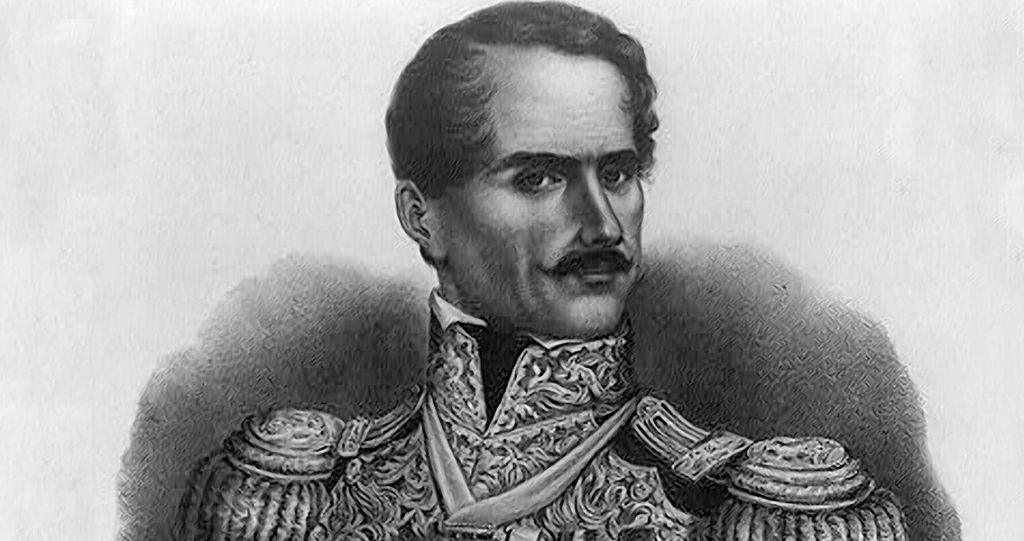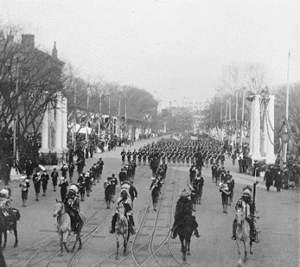
Santa Anna is one of the foremost figures in Mexico’s national history. His long life spanning eighty years was filled with important events and persons who influenced the history of Mexico for nearly a half of a century. Antonio Lopez de Santa Anna was born on February 21, 1794, in the province of Vera Cruz in eastern New Spain, now modern day Mexico.1 The last decade of the eighteenth century and the beginning of the nineteenth century was full of chaos and dynamic changes in the relationship between Spain and its colonies. During the independence movements from 1810 to 1824, many colonies revolted against the mother country. These uprisings in Spain’s colonies aided Napoleon’s invasion of the Iberian Peninsula. Santa Anna was born into this era of chaos, revolution, and almost continual warfare.2

Santa Anna intermittently became the president of Mexico. He headed the nation on eleven occasions. It is important to understand his transition from the army to the presidency. Santa Anna developed an early interest in the military life. His keen interest in the military can be easily seen in his writings from one of his early journals; he wrote in his journal thoughts he had as a child, that the army was for him “the glorious carrier of arms, feeling in a true vocation.”3 His long journey in serving his nation began at the age of sixteen, on June 9, 1810, when he joined the Spanish army. He started as an infantry soldier, and transferred to the cavalry unit eventually. The cavalry units required more experienced and skilled soldiers. His commanders could easily see his talent for warfare and strategy. After a year of training, his first military mission took place in 1811, against rebels in Nuevo Santander. Santa Anna’s first direct action was capturing and executing the bandit leader. His commanders applauded him for his courageous action. Moreover, his most distinguished activity during his early military life occurred on May 10, 1812; while fighting with insurgents, he fought ferociously and his commander lauded Santa Anna’s courageousness and called him “dignified.”4 During his battles with rebels, he suffered several wounds, specifically a severe wound on his left arm. However, his wounds did not stop him. Santa Anna fought against rebels throughout his career in the military. His service in the army was even recognized by the Spanish King, and he was promoted to second-lieutenant.5 Young Santa Anna was being promoted rapidly. In a short amount of time, he became a captain. To the experienced eye, his heroism and sagacious leadership made him a promising candidate for the General position in the Army.
Santa Anna gained much prestige in 1829 when he fought against Spain’s attempt to reconquer Mexico. During this battle, he defeated the 2,700 Spanish soldiers under command of General Barradas. After this victory, Santa Anna became known as the Hero of Tampico. This glory significantly helped him to become the President in 1831. His turbulent political life started after these promotions in the army, in which he intermittently came to power eleven times.
Santa Anna became one of the foremost figures in Mexico’s history through his courage in the military and the feeling of serving for his nation.
- Oakah Jones, Santa Anna (New York, Twayne Publishers 1968), 67. ↵
- Jones, Santa Anna, 67. ↵
- Jones, Santa Anna, 49. ↵
- Wilfrid Hardy Callcott, Santa Anna: The Story of an Enigma Who Once Was Mexico (University of Oklahoma Press, 1936), 365. ↵
- Skipper Steely, Santa Anna: prisoner of war in Texas (Wright Press, 1986), 73. ↵



42 comments
Cameron Adelman
I feel like this article was incomplete; the part that you did have was interesting and well-written, but the ending felt a little rushed. It would have been nice to hear some more detailed information regarding his role in defending Royalist New Spain, his involvement in the Mexican revolution, and his many stints in the Mexican government. Anyway, on its own merits, you did a very solid job writing this article. Well done.
Irene Astran
This is a very inspiring story. I think you did a good job in describing his upward mobility in rank. As a Political Science major my interest was naturally drawn towards the end of the article when you write about his being elected president. I think adding a chunk of information about his term would have also benefited this article.
Andrew Gray
This was a very insightful article on Santa Annas life. I would say early military life but it sure seemed that military was in fact his whole life considering how young he began his career. Being from Houston I used to go to the San Jacinto Battleground where the famous battle between Sam Houston and Santa Anna’s Mexican army took place and watched the reenactment that is hosted there on the anniversary of the battle every year.
Nataly Solis Chavez
I had previously learned about Santa Anna but not in such detail, we quickly went over it in middle school and since then I had forgotten all about it. To this day im still in awe as to how Santa Anna was ale to come to power at such a young age, by the age of 16 I couldn’t even do my own laundry. In the end he definitely made his mark in history.
Zaraly Frasquillo Bejarano
Great article! I loved that it was very brief but very informative. My grandpa was a history teacher in Mexico and i remember him mentioning something about Santa Ana but I never really payed much attention. But after reading your article I feel like i can call my grandfather and make him proud that I know something about the Mexican history.
Priscilla Reyes
General Santa Anna is well known by many, because of his long career. We’ve almost always heard of him as a tyrant, and I love how you choose to be objective and informative of his accomplishments and his motives for serving in the military. Through the good and bad, he served his country and stood for it when needed. Maybe a tyrant, maybe a radical, but definitely a strong man when it came to decision making.
Alexis Soto
Santa Ana truly is a famous or infamous character in Mexico’s history. The information presented here was a great way of showing the reader the personal story and reasoning for Santa Ana’s long service to his country. Reading of his accomplishments and achievements one gets a different view if one had only read of his political career as President. One cannot say Santa Ana did not serve his country as he served from a young age and influenced Mexico even after death.
Victoria Sanchez
The comment you make at the end of the first paragraph–stating that Santa Anna “was born into this era of chaos, revolution, and almost continual warfare”–was a great segue and foreshadowing of what was to come in his life as a General and eleven-time President of Mexico. The explanation you provided for the journey through the military that led him to become a General and President was well-detailed, and I think it is important that you made clear the fact that he climbed the ladder to reach the positions he held.
Alejandro Alcala
Wow! This article is so informative. It’s crazy how a young soldier, for a once prosper nation, could be promoted so fast and be in power 11 times. I didn’t know much about Santa Anna besides his escapades in Texas and the Alamo. He was always the “bad guy” to me, since I grew up here in San Antonio. But I can see he was just serving his nation, which he seemed to love. Awesome Article!
Tina Valdez
I was shocked to hear that Santa Anna came into power eleven times. I knew about his success and glory as the Hero of Tampico, but the detail you provided was much appreciated. It is also difficult to imagine that his serving the nation began at the young age of 16. He was certainly committed. Very informative article!